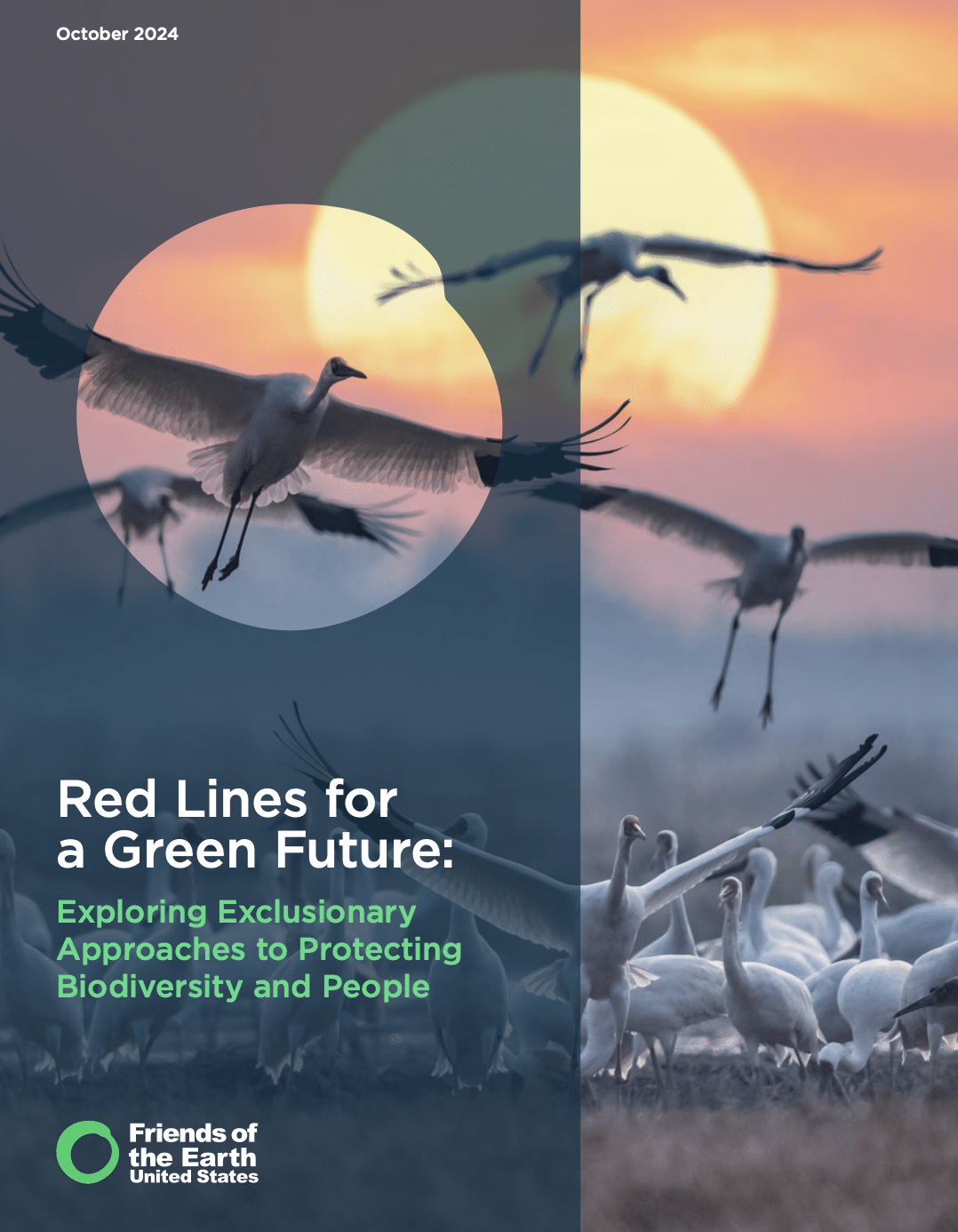Red Lines for a Green Future: Exploring Exclusionary Approaches to Protecting Biodiversity and People

The global biodiversity crisis has escalated to unprecedented levels, with ecosystems deteriorating rapidly. One of China’s responses, the Ecological Conservation Red Lines (ECR), offers a novel approach to protecting biodiversity and ecosystem functions by strictly prohibiting harmful activities in key areas. A new report from Friends of the Earth US explores how China’s ECR framework can inspire global financial institutions, particularly Chinese banks, to adopt exclusionary financing policies in their investments, thereby mitigating environmental risks and contributing to global efforts to halt and reverse biodiversity loss. The new report, “Red Lines for a Green Future: Exploring Exclusionary Approaches to Protecting Biodiversity and People,” recommends aligning with the Banks and Biodiversity Initiative’s proposed No Go areas as a basis for creating exclusionary policies as a means to safeguard critical ecosystems from harmful development in China and abroad.
Read the report here
Read the fact sheet here
Key Recommendations
To enhance the role of the finance sector in global biodiversity conservation, international and Chinese banks should:
- Develop and Publish a Biodiversity Plan and Strategies: To implement the Global Biodiversity Framework, international and Chinese financiers should develop and publish a robust biodiversity plan and strategies with concrete targets, goals, and performance indicators to stop and reverse biodiversity loss by 2030.
- Adopt Exclusion Policies: International and Chinese financiers should develop and implement financial exclusion policies that align with the principles of the Ecological Red Lines and the Banks and Biodiversity’s “No-Go Areas.” These policies should explicitly prohibit financing projects and activities that harm critical ecosystems, and should be adopted as part of a banks’ risk management framework or existing exclusion lists.
- Integrate ECR Criteria in Due Diligence: International and Chinese financial institutions should incorporate and evaluate ecosystem functions and ecosystem integrity as key parts of environmental and social risk assessments.
- Adopt and Implement Strong Indigenous Peoples Rights Policies: International and Chinese financiers should develop, adopt, and publish Indigenous Peoples Rights policies, if they do not already.
- Require Free, Prior, Informed Consent: International and Chinese financiers should require themselves and their clients to comply with free, prior, and informed consent as an ongoing, iterative process for all activities which may impact Indigenous Peoples and affected communities, and respect scenarios where consent may conditionally be given, or not given at all.
- Develop and Disclose Loan Covenants related to Environmental, Social, Biodiversity, and Climate Obligations: International and Chinese banks should develop and publicly disclose loan covenants related to environmental, social, biodiversity, and climate obligations to ensure client accountability.
- Holistically Develop, Strengthen, and Expand on Cross-cutting Policies: International and Chinese banks and financiers should holistically develop, strengthen, and expand on policies which are inherently crosscutting, such as climate, biodiversity, and Indigenous Peoples, so that respective frameworks are aligned and do not conflict.
- Enhance Transparency and Accountability: International and Chinese banks should publicly disclose their exclusion policies and provide regular updates on their implementation. This transparency can build trust and demonstrate a commitment to environmental stewardship.
- Strengthen communication channels and grievance mechanisms: International and Chinese banks should strengthen communication channels with the public to understand and engage with various stakeholders, including affected communities, on the potential or existing risks of bank-financed activities. This includes providing current contact information on bank websites, substantively responding to community and public concerns promptly, and establishing an open, accessible grievance mechanism for communities who are negatively impacted by existing bank financing.
- Commit to Implementing the Global Biodiversity Framework: International and Chinese banks should publicly commit to implementing the Global Biodiversity Framework. For Chinese banks, this is in line with China’s National Biodiversity Action Plan, as well as their longstanding obligation under various Chinese overseas and green finance policies to follow international norms.
Ways to Support Our Work

Read Latest News
Stay informed and inspired. Read our latest press releases to see how we’re making a difference for the planet.

See Our Impact
See the real wins your support made possible. Read about the campaign wins we’ve fought for and won together.

Donate Today
Help power change. It takes support from environmental champions like you to build a more healthy and just world.